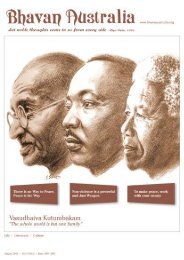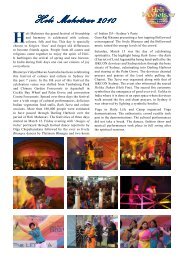Issue 8.5 - Bharatiya Vidya Bhavan Australia
Issue 8.5 - Bharatiya Vidya Bhavan Australia
Issue 8.5 - Bharatiya Vidya Bhavan Australia
Create successful ePaper yourself
Turn your PDF publications into a flip-book with our unique Google optimized e-Paper software.
India:<br />
No Longer<br />
Handcuffed to<br />
History<br />
New Delhi: A recent court ruling has revealed<br />
India’s strengths and limitations as it grapples with<br />
its transformation from a land handcuffed to<br />
history—ever since the Partition of 1947, which<br />
carved Pakistan out of its stooped shoulders—into<br />
a modern global giant.<br />
The High Court of India’s most populous state,<br />
Uttar Pradesh, finally decided a 61-year-old suit<br />
over possession of a disputed site in the temple<br />
city of Ayodhya, where, in 1992, a howling mob of<br />
Hindu extremists tore down the Babri Masjid<br />
mosque. The mosque was built in the 1520’s by<br />
India’s first Mogul emperor, Babur, on a site<br />
traditionally believed to have been the birthplace<br />
of the Hindu god-king Ram, the hero of the 3,000year-old<br />
epic, the Ramayana. The Hindu zealots<br />
who destroyed the mosque vowed to replace it<br />
with a temple to Ram, thereby avenging 500 years<br />
of history.<br />
India is a land where history, myth, and legend<br />
often overlap; sometimes Indians cannot tell the<br />
difference. Many Hindus claim that the Babri<br />
26 | <strong>Bhavan</strong> <strong>Australia</strong> | Nov 2010<br />
Masjid stood on the precise spot of Ram’s birth and<br />
had been placed there by Babur to remind a<br />
conquered people of their subjugation. But many<br />
historians—most of them Hindu—argue that there<br />
is no proof that Ram ever existed in human form,<br />
let alone that he was born where believers claim.<br />
More to the point, they argue, there is no proof that<br />
Babur demolished a Ram temple to build his<br />
mosque. Thus, to destroy the mosque and replace<br />
it with a temple was not righting an old wrong but<br />
perpetrating a new one. The Archaeological Survey<br />
of India, however, reported the existence of ruins<br />
beneath the demolished mosque that might have<br />
belonged to an ancient temple. The dispute<br />
remained intractable, and dragged interminably<br />
through the courts.<br />
To most Indian Muslims, the dispute is not about a<br />
specific mosque. The Babri Masjid had lain unused<br />
for a half-century before its destruction, as most of<br />
Ayodhya’s Muslims had emigrated to Pakistan after<br />
Partition. Rather, the issue was their place in Indian<br />
society.









